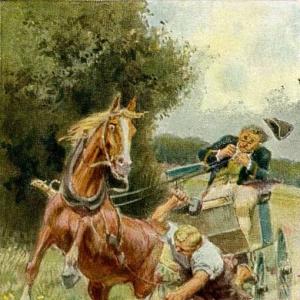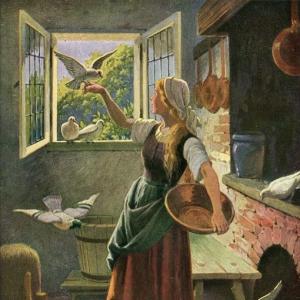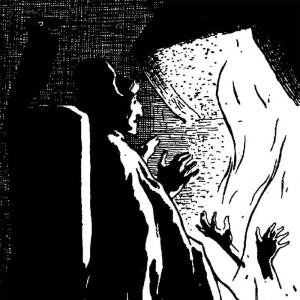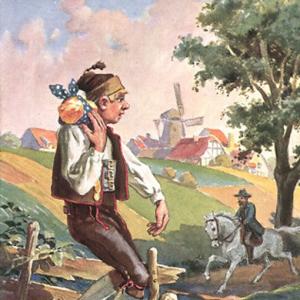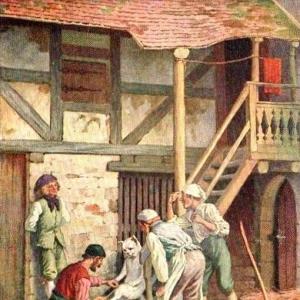Reading time for children: 7 min
In a certain village there once lived a man and his wife, and the wife was so idle that she would never work at anything; whatever her husband gave her to spin, she did not get done, and what she did spin she did not wind, but let it all remain entangled in a heap. If the man scolded her, she was always ready with her tongue, and said, „Well, how should I wind it, when I have no reel? Just you go into the forest and get me one.“ – „If that is all,“ said the man, „then I will go into the forest, and get some wood for making reels.“ Then the woman was afraid that if he had the wood he would make her a reel of it, and she would have to wind her yarn off, and then begin to spin again. She bethought herself a little, and then a lucky idea occurred to her, and she secretly followed the man into the forest, and when he had climbed into a tree to choose and cut the wood, she crept into the thicket below where he could not see her, and cried,
„He who cuts wood for reels shall die,
And he who winds, shall perish.“
The man listened, laid down his axe for a moment, and began to consider what that could mean. „Hollo,“ he said at last, „what can that have been; my ears must have been singing, I won’t alarm myself for nothing.“ So he again seized the axe, and began to hew, then again there came a cry from below:
„He who cuts wood for reels shall die,
And he who winds, shall perish.“
He stopped, and felt afraid and alarmed, and pondered over the circumstance. But when a few moments had passed, he took heart again, and a third time he stretched out his hand for the axe, and began to cut. But some one called out a third time, and said loudly,
„He who cuts wood for reels shall die,
And he who winds, shall perish.“
That was enough for him, and all inclination had departed from him, so he hastily descended the tree, and set out on his way home. The woman ran as fast as she could by by-ways so as to get home first. So when he entered the parlour, she put on an innocent look as if nothing had happened, and said, „Well, have you brought a nice piece of wood for reels?“ – „No,“ said he, „I see very well that winding won’t do,“ and told her what had happened to him in the forest, and from that time forth left her in peace about it. Neverthless after some time, the man again began to complain of the disorder in the house. „Wife,“ said he, „it is really a shame that the spun yarn should lie there all entangled!“ – „I’ll tell you what,“ said she, „as we still don’t come by any reel, go you up into the loft, and I will stand down below, and will throw the yarn up to you, and you will throw it down to me, and so we shall get a skein after all.“ – „Yes, that will do,“ said the man. So they did that, and when it was done, he said, „The yarn is in skeins, now it must be boiled.“ The woman was again distressed; She certainly said, „Yes, we will boil it next morning early.“ but she was secretly contriving another trick. Early in the morning she got up, lighted a fire, and put the kettle on, only instead of the yarn, she put in a lump of tow, and let it boil. After that she went to the man who was still lying in bed, and said to him, „I must just go out, you must get up and look after the yarn which is in the kettle on the fire, but you must be at hand at once; mind that, for if the cock should happen to crow, and you are not attending to the yarn, it will become tow.“ The man was willing and took good care not to loiter. He got up as quickly as he could, and went into the kitchen. But when he reached the kettle and peeped in, he saw, to his horror, nothing but a lump of tow. Then the poor man was as still as a mouse, thinking he had neglected it, and was to blame, and in future said no more about yarn and spinning. But you yourself must own she was an odious woman!
 Learn languages. Double-Tap on one word.Learn languages in context with Childstories.org and Deepl.com.
Learn languages. Double-Tap on one word.Learn languages in context with Childstories.org and Deepl.com.Backgrounds to fairy tale „The lazy spinner“
„The Lazy Spinner“ is a lesser-known fairy tale collected by the Brothers Grimm in their book „Grimms‘ Fairy Tales.“ The story belongs to the Aarne-Thompson-Uther (ATU) folktale classification system as type 1405, which involves a lazy woman trying to deceive others about her work.
The tale focuses on a woman who is too lazy to spin yarn. Her husband, a hardworking man, becomes frustrated with her lack of productivity and insists that she spin. To avoid work, the woman hatches a plan to deceive her husband. She covers her face with dough and pretends to be ill, claiming that her skin has become swollen from spinning too much. The husband, concerned for her health, agrees to let her rest.
Later, the woman sees a peddler selling cloth and decides to buy some to pretend that she has finished spinning. The peddler, however, will only sell the cloth if the woman agrees to let him smear pitch on her spinning wheel, a trick that reveals her deception. When the husband discovers the pitch-covered wheel and realizes his wife’s deceit, he tells her to spin properly in the future.
The story’s origins can be traced back to European oral storytelling traditions. „The Lazy Spinner“ is an example of a cautionary tale that warns against laziness and deception. The story also provides a glimpse into the domestic and gender roles of the time, as spinning was considered an essential household task for women.
As part of their work, the Brothers Grimm collected and documented numerous tales like „The Lazy Spinner,“ preserving oral storytelling traditions and ensuring that these stories would continue to be shared and enjoyed by future generations.
Interpretations to fairy tale „The lazy spinner“
„The Lazy Spinner“ is a lesser-known fairy tale from the Brothers Grimm that offers several themes and moral lessons. Some key interpretations of the story include:
The consequences of laziness and deception: The main theme of the story revolves around the consequences of being lazy and trying to deceive others. The lazy spinner attempts to avoid work and deceive her husband but is ultimately exposed, teaching a lesson about the importance of honesty and hard work.
Gender roles and societal expectations: The story reflects the societal expectations and gender roles prevalent at the time it was written. Spinning was considered an essential task for women, and the tale serves as a reminder of the importance of fulfilling one’s duties and responsibilities within the household.
The importance of hard work: The lazy spinner’s husband is portrayed as a hardworking man who values productivity and diligence. The story highlights the importance of hard work and the consequences of neglecting one’s duties.
Trickery and consequences: The peddler, who plays a crucial role in the story, uses trickery to expose the lazy spinner’s deception. This element of the tale emphasizes that deceitful behavior can be uncovered and that there are consequences for dishonest actions.
The value of cooperation within a family: The story also serves as a reminder of the importance of cooperation and working together within a family unit. The lazy spinner’s unwillingness to contribute to the household tasks puts a strain on her relationship with her husband and ultimately leads to her exposure and a lesson learned.
Overall, „The Lazy Spinner“ is a cautionary tale that emphasizes the importance of hard work, honesty, and fulfilling one’s duties and responsibilities. The story also reflects the societal expectations and gender roles of its time, providing insight into historical domestic life and the values of the era.
Adaptions of the fairy tale „The lazy spinner“
While „The Lazy Spinner“ may not be as well-known as other fairy tales from the Brothers Grimm, it has been adapted and included in various forms over the years. Some specific examples of adaptations include:
Literature: The tale has been included in several fairy tale collections and anthologies, such as:
„Grimm’s Fairy Tales“ by Jacob and Wilhelm Grimm, which features the original version of the story.
„The Complete Grimm’s Fairy Tales“ by Jacob and Wilhelm Grimm and Pantheon Books, an extensive collection of Grimm’s tales, including „The Lazy Spinner.“
Audiobooks and Radio Dramas: Audio adaptations of the tale have been produced, such as:
„Grimm’s Fairy Tales“ by LibriVox, a collection of audiobook recordings of Grimm’s fairy tales, which includes a recording of „The Lazy Spinner.“
Theater and Puppetry: Adaptations of the story have been created for stage performances, often as part of a larger collection of Grimm’s tales. These adaptations may take creative liberties with the source material, reinterpreting the story or incorporating it into a larger narrative.
Art and Illustration: The story has been visually interpreted by various artists and illustrators in books and other mediums, providing visual depictions of the lazy spinner and her attempts to deceive her husband.
Although „The Lazy Spinner“ may not have as many adaptations as some of the more famous Grimm’s fairy tales, its story and moral lessons continue to be shared through literature, audio recordings, and visual interpretations.
Adaptions of the fairy tale „The lazy spinner“
„The Lazy Spinner“ has been adapted in various forms over the years, including:
Children’s books: Several children’s books have been published based on the fairy tale, including „Lazy Kate“ by Mary Elizabeth Hanson and „The Lazy Spinner“ by Doris Orgel.
Animated films and television shows: The tale has also been adapted into animated films and television shows, such as „Simsala Grimm,“ „Sprookjesboom,“ and „Storytime with Barney.“
Plays and musicals: „The Lazy Spinner“ has also been adapted for the stage, with productions such as „The Lazy Girl“ by Viva Las Vegas and „The Lazy Spinner“ by Tricia Lee Wilkins.
Retellings and reimaginings: The tale has also inspired retellings and reimaginings, such as „The Spinning Heart“ by Katherine E. Wills and „The Lazy Spinner and the Tales of Baba Yaga“ by K.V. Dominic.
Visual arts: The story has also been adapted into various forms of visual art, including paintings, illustrations, and sculptures.
These adaptations often take creative liberties with the original tale, adding new characters, plot elements, and themes. However, they typically retain the core elements of the story, such as the importance of hard work, the danger of breaking promises, and the power of forgiveness.
Summary of the plot
„The Lazy Spinner“ is a lesser-known fairy tale from the Brothers Grimm about a woman who is too lazy to spin yarn. Her husband, a hardworking man, grows frustrated with her lack of productivity and insists that she spin. In order to avoid work, the woman devises a plan to deceive her husband by covering her face with dough and pretending to be ill, claiming her skin has become swollen from too much spinning. Concerned for her health, the husband allows her to rest.
Later, the woman sees a peddler selling cloth and decides to buy some to pretend she has finished spinning. However, the peddler agrees to sell her the cloth only if he can smear pitch on her spinning wheel. This trick ultimately reveals her deception to her husband, who discovers the pitch-covered wheel.
Upon realizing his wife’s deceit, the husband tells her to spin properly in the future. The story serves as a cautionary tale, emphasizing the consequences of laziness and deception, the importance of honesty and hard work, and the societal expectations and gender roles of the time.
————–
Backgrounds to fairy tale „The lazy spinner“
„The Lazy Spinner“ is a lesser-known fairy tale from the collection of Brothers Grimm, who were German academics and authors known for their popularization of folk tales. The brothers, Jacob and Wilhelm Grimm, collected and published numerous stories during the 19th century, which became part of their famous work „Grimms‘ Fairy Tales“ (originally published as „Children’s and Household Tales“ in 1812). The collection includes well-known tales such as „Cinderella,“ „Snow White,“ „Rapunzel,“ and „Hansel and Gretel.“
The Brothers Grimm aimed to preserve German folklore and culture through their tales, which often reflected the social norms, beliefs, and values of their time. Fairy tales like „The Lazy Spinner“ were typically passed down orally before being recorded by the Grimm brothers. These tales often featured magical or supernatural elements, along with moral lessons that were meant to teach and entertain both children and adults.
In the context of „The Lazy Spinner,“ the story showcases the challenges of traditional gender roles, communication issues in relationships, and the consequences of deceit and laziness. Like many other Grimm fairy tales, this story was intended to entertain and educate readers about the potential dangers of manipulation and the importance of honest communication in relationships.
Interpretations to fairy tale „The lazy spinner“
There are several interpretations one can draw from „The Lazy Spinner“:
Manipulation and deceit: The wife’s cunning and deceitful tactics to avoid work demonstrate the negative consequences of manipulation in relationships. The story serves as a cautionary tale against using deception to achieve personal goals at the expense of others.
Gender roles and expectations: The tale reflects the traditional gender roles and expectations of the time, where women were primarily responsible for domestic chores. The wife’s reluctance to perform her duties highlights the limitations and constraints these roles can impose.
The importance of communication: The story emphasizes the need for open and honest communication in relationships. The husband’s inability to express his concerns effectively and the wife’s deceitful behavior prevent them from reaching a resolution.
Consequences of laziness: The tale serves as a moral lesson about the consequences of laziness and avoidance of responsibility. The wife’s unwillingness to work leads to disorder and conflict in their home.
Power dynamics in relationships: The story illustrates the power dynamics in relationships, with the wife using manipulation and deceit to maintain control. This dynamic can lead to an unhealthy and unbalanced relationship.
Overall, „The Lazy Spinner“ presents a cautionary tale about manipulation, deceit, and the importance of communication in relationships. It also explores the limitations of traditional gender roles and the consequences of laziness and avoidance of responsibility.
Summary of the plot
„The Lazy Spinner“ is a fairy tale by Brothers Grimm about a man and his idle wife who lived in a village. The wife refused to work and left her spun yarn entangled. When the husband urged her to wind the yarn, she told him to make her a reel from the forest. Fearing she would have to spin again if he did, she secretly followed him and cried out a warning, causing him to abandon his task.
The wife then tricked her husband into believing he ruined the yarn while boiling it. From that point on, he no longer complained about her spinning or the mess in their house. The story highlights the cunning and deceitful nature of the wife, showcasing her as an odious woman.
Informations for scientific analysis
Fairy tale statistics | Value |
|---|---|
| Number | KHM 128 |
| Aarne-Thompson-Uther-Index | ATU Typ 1405 |
| Translations | DE, EN, DA, ES, PT, IT, JA, NL, PL, RU, TR, VI, ZH |
| Readability Index by Björnsson | 31 |
| Flesch-Reading-Ease Index | 82 |
| Flesch–Kincaid Grade-Level | 7.6 |
| Gunning Fog Index | 10.6 |
| Coleman–Liau Index | 6.1 |
| SMOG Index | 8.1 |
| Automated Readability Index | 7.7 |
| Character Count | 3.825 |
| Letter Count | 2.859 |
| Sentence Count | 33 |
| Word Count | 768 |
| Average Words per Sentence | 23,27 |
| Words with more than 6 letters | 59 |
| Percentage of long words | 7.7% |
| Number of Syllables | 919 |
| Average Syllables per Word | 1,20 |
| Words with three Syllables | 24 |
| Percentage Words with three Syllables | 3.1% |


